How To Clean Log Cabin Exterior Walls? Complete Guide
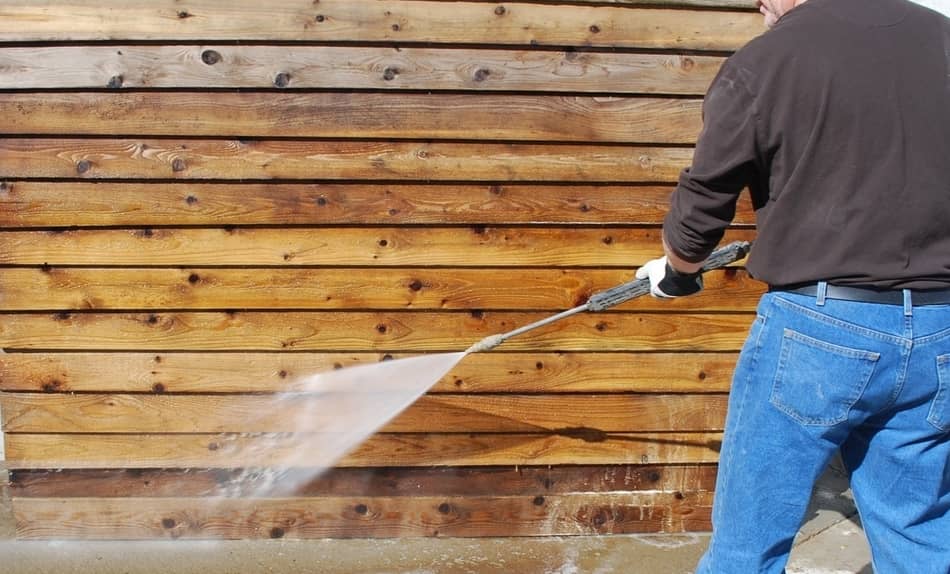
Most people build their log cabins in nature, near rivers or lakes, and among trees. While it is lovely to be surrounded by nature, it can cause buildup and stains on your beloved log house. Muck, moss, mowed grass, and other similar things can also ruin your external wood. Routine maintenance of your log cabin can help prevent stains, rotting, and insects from attacking your logs. In this article, we’ll talk about that and much more. So, let’s start!
Table of Contents
How To Clean Log Cabin Exterior Walls?
So How To Clean Log Cabin Exterior Walls? Usually, to clean exterior walls on a cabin, use the wash brush that comes with a long handle and scrubs its surface with it. Make sure to use clear water and rinse thoroughly after you’re finished washing and scrubbing. Wait around 48 to 72 hours for the walls to dry before examining the surface.
With proper maintenance, log homes may survive for generations. Maintaining your log cabin’s exterior can keep it in good shape and look attractive. Because log cabins are so distinct from other structures, they require special exterior care. It would be best if you were mainly focused on wood, cleaning it, and taking care of it.
You will surely be interested in this article as well, so feel free to check out Log Cabin Maintenance Costs: The Complete Guide.
Equipment Needed To Wash Your Log Home’s Exterior
There aren’t many cleaning supplies you’ll need for your log cabin. Unless you want to re-stain, you won’t need pricey tools or a power washer. Here are the essential things that you’ll need.
You’ll require the following items:
- Hose/Water – A proper nozzle with a mist setting on your hose is recommended.
- Bucket – To mix your cleaner, you’ll need a bucket.
- Rag, mop, brush, or heavy-duty sponge – depending on your preferences. To scrub effectively, We prefer to use a brush.
- Log Cleaner – There are several log cleaners on the market; we choose TSP (Trisodium Phosphate), but other people use cleaners such as OxiClean. Dish soap and bleach should not be used since they will ruin the stain.
- Nice Weather – Confirm that it will not rain on that particular day.
Step-by-Step Log Cabin Cleaning Guide
It’s critical to identify the root of the problems before cleaning the exterior of your log home. You might have two possible issues: mud on the logs because of the rain or shrubs or other vegetation growing too near your log cabin. Before you clean the outside of your log cabin, figure out what’s creating the issue and try to solve it. This will help your log cabin and logs last for a lifetime, and it will also help keep insects and pests at bay in most circumstances.
1. Log Cabin Exterior Walls
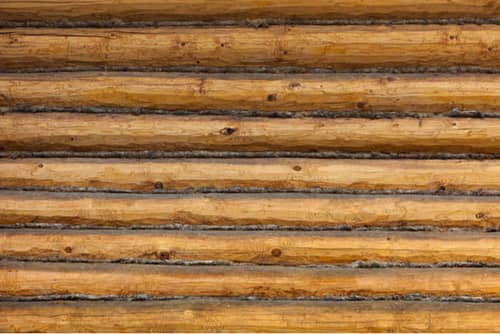
Hose down the whole exterior of your log cabin, giving special attention to places where dust, dirt, and cow accumulate. The dirtiest part of any log cabin is frequently under the eaves, around corners, and doors and windows.
The most significant results will be obtained if you use an exterior cleaning solution that is not toxic and that can be used and rinsed off afterward. Scrub the area with a long-handled soft car wash brush. After washing and cleaning, thoroughly rinse the walls with clear water. And lastly, before inspecting the surface, make sure that the walls are dry for at least two days.
Is your log cabin’s outdoor wood finished in any way? What do you think of that finish? When we talk about renewing the finish, it’s not that easy; you will have to do more than reapply the same product or clean the surface.
Never use a power washer to clean the walls of a wood cabin! Softwood is used in almost all log cabins, and it’s far too simple to scratch the wood’s surface or gets water between the logs unintentionally. We recommend using water from a garden hose and a soft brush for the wood than using a power washer.
Even if you wash your logs often, deterioration and mold development might occur over time. Sanding can help in this situation. Any sander should work pretty nicely to remove discolored wood and prep the surface to absorb and retain stain or sealer, but we used a 6″ orbit sander with an 80-grit disk.
Related Article: Can You Get Cigarette Smoke Out of Log Cabin?
2. Log Cabin Exterior Gutters
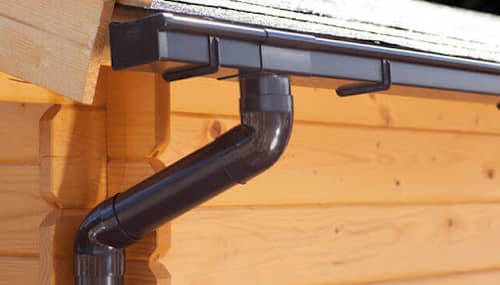
Clear the gutters of all leaves and twigs. Then look for any potential fractures and cracks of water leakage. First-story gutters need to be cleaned while standing securely on the ground with gutter cleaning equipment that links to your garden hose. With the bent washing tool, reach up and blow away any dirt, tiny leaves, or pebbles that may have accumulated on your shingles.
Checking for overflowing gutters and leaks is best done during wet weather when there is rain. Inspect the gutter hardware and tighten or replace the ones that are loose. To make future gutter cleaning easier, consider installing a leaf guard.
3. Log Cabin Windows
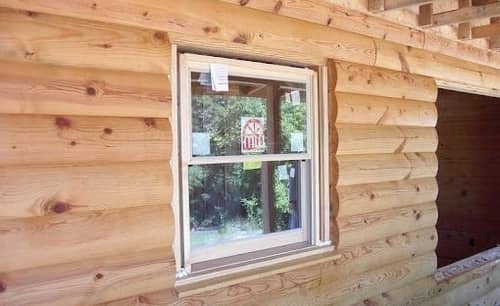
Glass on the windows must be cleaned (inside and out). Next, check the ease with which they open and close. A small amount of spray lubricant is good to apply to the hardware and sliding surface of the window. Is there any moisture between the panes of your windows? If the answer is yes, it indicates that the windows are not energy-efficient as when you first installed them.
The barrier between the glass panes has weakened, enabling the insulating gas to escape and moisture to enter and condense in the cavity. Although some companies can repair broken window seals without dismantling them, some broken windows can’t be repaired and must be replaced.
4. Log Cabin Roof
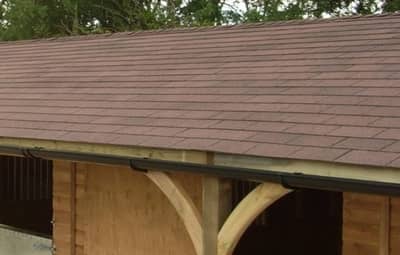
From the ground, inspect shingles or the roof metal. If the shingles on your roof are curling, it’s an indication that you need to replace your roof. If the metal roofing appears to be loose, it should be fixed with screws. You can choose any hardware you want for holding down metal roofs, but we recommend using screws with synthetic rubber washers that are under their heads.
Moss on your roof is also one of the problems. Rooftop moss reduces the life of asphalt shingles, but it may be avoided, even if there are trees nearby. To prevent moss and lichen development, you can install zinc strips every 15 ft under the top layer of shingles. However, keep in mind that they don’t always destroy existing growths. If the shingles on your cabin roof have moss on them, use a moss-killing solution before applying zinc strips.
Many log cabins include wood fascia (the vertical border of a standard roof). Roof runoff and sunshine make it tough to maintain a polished wooden fascia and look lovely in this hostile climate. Consider using factory-finished aluminum to cover high-maintenance timber fascia. Every existing wooden fascia may easily be adapted with this, and it’s less work compared to refinishing, looks better, and saves you at least 20 years of fascia maintenance headaches.
5. Log Cabin Deck or Patio
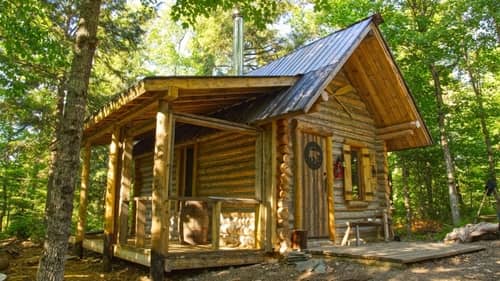
If you have a deck that is built out of wood, clean it the same way you cleaned the cabin’s outside. After that, examine the deck structure and the finish objectively.
If deck wood is in good condition, use an oxygen-based cleaner to remove any mold or mildew. Then wait for the surface to dry. The quickest approach to properly prepare a hardwood deck for refinishing is to pressure wash it first, then again use a 6-inch sander with an 80-grit abrasive once it has dried completely. Clean your paver patio with clean water and a long-handled brush if your cabin has one.
Reasons To Clean the Exterior of Your Log Home
- Pollen, dust, and other airborne impurities create a food supply for fungus development on your logs.
- Maintain the appearance and durability of your exterior finish.
- Allows you to examine the condition of your logs to see if any spots require chinking or caulking.
- If you’re using a contact pesticide, dirt on your home’s exterior will prevent bugs from reaching the treated area, rendering the insecticide ineffective.
- A light washing of the outside of your property regularly can extend the life of the stain of your log cabin.
Reasons to Avoid Bleach Or Ammonia Based Products
- Bleach is hard to remove, and the finish after washing may seem patchy
- It destroys lignan in the wood
- Your wood’s surface may acquire streaks
- Has the ability to erase color permanently
- When the residue settles on the ground, it becomes a carcinogen
How to Clean Your Log Home
- Choose a small area. Only clean an area large enough for the cleaning solution to remain on the wall for 10-15 minutes.
- Spray a mist of water down the wall using your garden hose.
- Apply the cleaning solution by using the garden sprayer to the whole wall, starting at the bottom and working your way up.
- Scrub. Scrub the wall gently with your brush.
- Rinse. Be sure to rinse the cleaner entirely from the top down using a moderate hose nozzle setting. Drip marks and blotches will be reduced as a result. To avoid breaking the wood fibers, use a power washer with a 500-800 PSI pressure range.
For those who want to learn more, feel free to read The Pros And Cons Of Log Cabin Homes.
FAQ: People Also Ask
1. Can you use sugar soap on exterior walls?
After removing or securing all obstacles, clean the walls thoroughly with a sponge and warm soapy water or sugar soap. Because the outside of a house attracts a lot more dirt than the inside walls, you’ll want to make sure any persistent dirt, dust, or spider webs are removed before applying the paint.
2. How do you get rid of mold on a log cabin?
Combine 1/2 cup biodegradable dishwashing soap with 1 part household bleach, and 4 parts water. Use this mixture and scrub the logs. Scrub the foundation from the bottom up, starting at the bottom and working your way to the top.
3. How long do log cabin homes last?
If appropriately built, log cabins can last anywhere from 20 to 50 years. If properly maintained and built in an area with no significant weather fluctuations, log homes can even endure a century. If built poorly, it may require extensive maintenance within the first five years.
4. Can you pressure wash a log cabin?
If you apply the proper technique, pressure washing your log cabin may be completely safe. Use a broad fan setting to keep the wand moving, especially at higher psi settings. Keeping the power washer in one location for an extended period or standing too near it might harm the timber.
5. How do you get the musty smell out of a log cabin?
During the summer, use a dehumidifier to minimize the amount of moisture in your home. You can place sidewalk chalk wrapped in cheesecloth or open bags of charcoal, which will absorb moisture and smells during the winter.
Final Thoughts
As you could see in this article there are several ways how you can clean a log cabin’s exterior walls. Remember that never use a power washer for cleaning as we have mentioned above. It is very important to do regular maintenance of your log cabin to make it last as long as possible. I hope this article helped you and if you have additional questions feel free to contact us.


I don’t think the title of your article matches the content lol. Just kidding, mainly because I had some doubts after reading the article. https://accounts.binance.com/de-CH/register?ref=GJY4VW8W
Your article helped me a lot, is there any more related content? Thanks! https://accounts.binance.com/fr/register?ref=V2H9AFPY
Can you be more specific about the content of your article? After reading it, I still have some doubts. Hope you can help me.